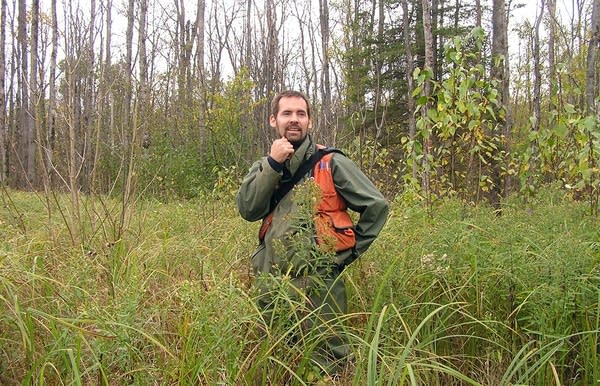In warmer climate, a bid to preserve trees threatened by emerald ash borer

Go Deeper.
Create an account or log in to save stories.
Like this?
Thanks for liking this story! We have added it to a list of your favorite stories.
Researchers from the U.S. Forest Service are trying to find ways to save northern Minnesota from the emerald ash borer, a tiny pest with a voracious appetite.
Since it was discovered in Michigan nearly 20 years ago, the emerald ash borer has killed millions of ash trees across the Midwest and Canada.

In Minnesota, infestations have been found in the Twin Cities and in the state's southeastern corner. In northern Minnesota, where there are more than one million acres of black ash forest containing nearly a billion trees, researchers say the threat is made worse by a changing climate.
Research suggests the pest is only kept at bay when temperatures dive 30 below zero.
Turn Up Your Support
MPR News helps you turn down the noise and build shared understanding. Turn up your support for this public resource and keep trusted journalism accessible to all.
"We're likely to have less and less winters reaching that extreme cold temperature," U.S. Forest Service researcher Brian Palik said. "So most likely, [emerald ash borer] populations will be enhanced with climate change. So you have a double whammy."
Last fall, Palik trekked about 40 miles northwest of Grand Rapids to the heart of Minnesota's black ash forest, in the Chippewa National Forest, where the trees are about 100 feet tall and nearly a century old. Their roots spread out above the ground, reaching deep into the earth.
It was one of the few times of the year when the forest is dry. Black ash trees are amazing water pumps and when they sprout leaves in the spring, their roots suck water out of the ground.
Palik and his colleagues at the forest service's Northern Research Station in Grand Rapids want to know what will happen when the emerald ash borer arrives.

"Will the system reorganize itself, will other species seed in, regenerate, survive, and form a forested canopy?" asked Rob Slesak, program manager for the Forest Resources Council.
If that occurs and new trees survive, he said, forest managers might not need to do anything.
To determine what will happen, they're conducting tests in the forest. A couple of years ago, the researchers simulated an emerald ash borer invasion by slowly killing thousands of trees on a four acre plot.
They used long knives to "girdle" the trees, cutting a deep gouge several inches wide around each tree's trunk to prevent it from conducting sugars produced from photosynthesis down to its roots.

They also clear cut another four acres.
In just two years, Slesak said, they saw a dramatic change.
"What we're really looking at is a very grass dominated wetland, which was once a forested wetland," he said.
The wetland contains cattails popping up, because without the trees to act as giant water pumps, the ground is too wet for the forest to reclaim it.
"Essentially it reaches almost a tipping point where it becomes so wet that no tree species can establish," Slesak said.
If it is inevitable that the emerald ash borer will arrive and kill the vast majority of the black ash trees, the big remaining question for researchers is whether they can keep these forested wetlands covered with other species of trees.
That's critical because forests provide a host of ecological benefits, including carbon storage, wildlife habitat, flood control and timber.
Ash forests in particular also provide specific cultural benefits. Native Americans from Maine to Minnesota use black ash to craft intricate baskets.
At another nearby research plot, Palik showed where loggers cut small patches of ash to create quarter-acre openings in the forest. They aimed to leave enough trees to control the rise of the water table, and then plant potential replacement species for black ash in the gaps.

So far, the species researchers think does the best job is swamp white oak, which grows farther to the south in Minnesota.
"So we're quite encouraged that this is a potential tree replacement," Palik said. "It's controversial in that we're assisting its migration up into this forest type, but we have to be thinking creatively and perhaps radically in the face of [emerald ash borer] with climate change."
The Chippewa National Forest is now starting to implement the research on a broader scale.
Land managers are analyzing two projects that will thin ash trees and plant potential replacement species over more than 4,000 acres.
Silviculturalist Audrey Gustafson said the agency plans to plant 8 to 10 species of trees, from conifers like tamarack and black spruce, to hardwoods such as yellow birch, red maple, and perhaps swamp white oak.
Foresters hope they can gradually shift the forest away from black ash over the next several years. But they fear that may not happen quickly enough before the inevitable arrival of the emerald ash borer.
"Some of us feel like this is taking too long to get through the process," Gustafson said. "But we've had other priorities. Now it's time to move forward with this, because we know it needs to get done."


